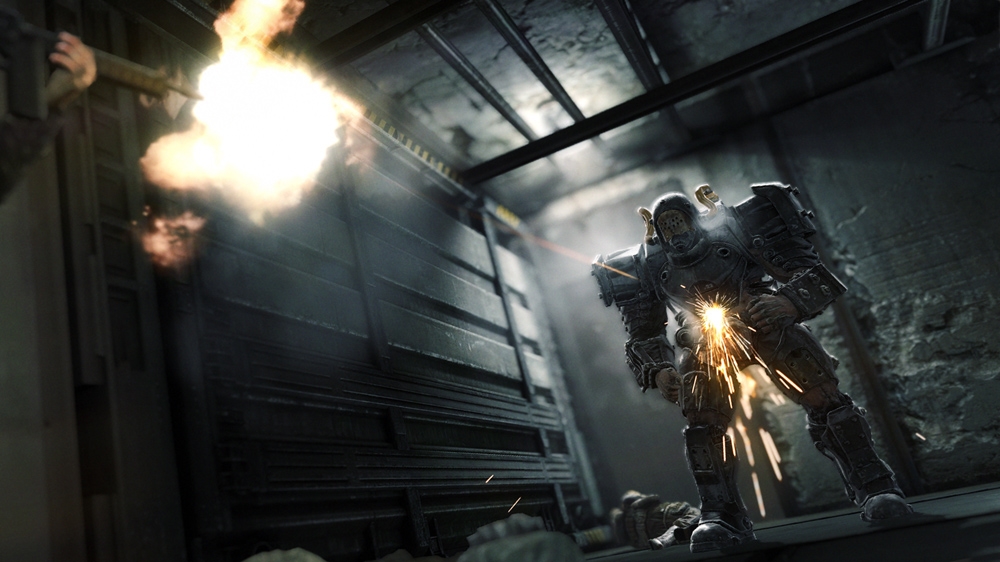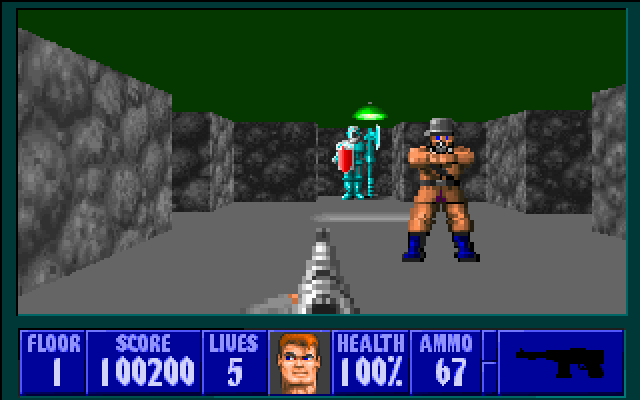
30 Years of Butt-Kicking: The History of Wolfenstein
“Halo.” “Call of Duty.” “Battlefield.” First-person shooters are some of the most purchased and played games in all of gaming—not just now, but for decades. And yet, few of even the most rabid players really know where this genre comes from. Quick, which game created the template for the FPS we know and love today?
If you said “Doom,” you’re not alone. You’re wrong, but you’re not alone. 1992’s “Wolfenstein 3D” holds that honor, predating its demon-packed successor by a year… and setting the stage for 20-plus years of staring at bad guys over the barrel of a gun.
This week, iron-jawed protagonist B.J. Blazkowicz returns in his first new adventure in almost five years, starring in “Wolfenstein: The New Order.” Which makes this an opportune time to take a look back at the series’ long and storied history—and its lesser-known origins.
“Castle Wolfenstein”
Released: 1981
Publisher: Muse Software
Developer: Muse Software
Launch Platform: Apple II
Yes, 1981. The first “Wolfenstein” game was released over 30 years ago, and it was so very not a first-person shooter. Instead, “Castle Wolfenstein” was a proto-stealth game viewed from an overhead perspective. It required players to sneak by guards, screen by screen, through the titular, Nazi-infested castle. It introduced innovations that would go on to become standards in the stealth genre, including swiping enemy uniforms and dramatically limited ammo—and shooting was essentially discouraged.
“Beyond Castle Wolfenstein”
Released: 1984
Publisher: Muse Software
Developer: Muse Software
Launch Platforms: Apple II, Commodore 64
Nope, still not a first-person shooter. “Beyond Castle Wolfenstein” simply iterated on its predecessor’s gameplay, introducing more stealth standbys (e.g. hiding bodies, silent kills), but still downplaying any shooting. Though only the setting of these first two games would carry forward into the many sequels, the gameplay wasn’t ignored. It helped influence its own stealthy branch of the gaming tree: We can thank these 30-year-old games for influencing (if even only indirectly) such franchises as “Thief” and “Metal Gear.”
“Wolfenstein 3D”
Released: 1992
Publisher: Apogee Software
Developer: id Software
Launch Platform: MS-DOS
Ah, now we’re talking. This is the game that started it all. It wasn’t the first first-person game, nor even the first first-person game that involved shooting. But it set the template for the genre that became known as the “first-person shooter,” with hero B.J. Blazkowicz mowing through waves of Nazis on his way to take on—wait for it—Mecha-Hitler. But why take our word for it? You can play it yourself on your Xbox 360 today.
“Spear of Destiny”
Released: 1992
Publisher: FormGen Corporation
Developer: id Software
Launch Platform: MS-DOS
This prequel appeared barely four months after “Wolfenstein 3D,” which might give you some idea of how popular its predecessor had become. Though, to be perfectly honest, there wasn’t a whole lot new in “Spear of Destiny”—it was primarily a selection of new levels with a few updated textures. Today it probably would have been DLC, but in those days, we had no way to pay for stuff online. Yes, kids, we’re old.
“Return to Castle Wolfenstein”
Released: 2001
Publisher: Activision
Developers: Gray Matter Interactive, Nerve Software, id Software
Launch Platform: Windows
In spite of the success of the previous two games, it took nearly a decade for a new “Wolfenstein” game to make the scene. But it was worth the wait: Variously described as a sequel or a reboot, “Return” brought the series dramatically and victoriously into the modern era, even making an appearance on the original Xbox. The extensive single-player story dealt with Nazis attempting to harness the power of the occult (see: “Raiders of the Lost Ark”), but the big addition was a robust multiplayer mode that earned high praise from, well, pretty much everyone.
“Wolfenstein: Enemy Territory”
Released: 2003
Publisher: Activision
Developers: Splash Damage, id Software
Launch Platform: Windows
In fact, the multiplayer in “Return” was so strong that it ended up being the entirety of the next game. Initially intended to be an expansion pack, then re-imagined as another full-fledged single- and multiplayer experience, “Enemy Territory” suffered a series of development setbacks. The result was that the game was eventually released as a multiplayer-only download—for free. You PC players can go ahead and check it out now. But be warned: You’ll need a whole 128 megabytes of RAM to run it.
Wolfenstein RPG
Released: 2008
Publisher: EA Mobile
Developers: Fountainhead, id Mobile
Launch Platforms: Java ME, BREW
Wait, what? RPG? BREW? What’s going on here? Well, get this: In 2005, id Software developed a turn-based version of “Doom” for what at the time were state-of-the-art cell phones. Touch-screen phones were still years away, so turn-based was pretty much the only way to go. The funny thing is, it totally worked. And thanks to its surprising success, “Wolfenstein” got its own version, complete with tile-based movement, turn-based combat, and even potions of a sort. Weird, right?

“Wolfenstein”
Released: 2009
Publisher: Activision
Developers: Raven Software, id Software, Endrant Studios
Launch Platforms: Xbox 360, Windows
Shortly thereafter, “Return to Castle Wolfenstein” finally got a proper sequel. Called simply “Wolfenstein,” the game played further on the idea of the Nazi fascination with the occult. Though not quite as celebrated as its predecessor, “Wolfenstein” provided the dense single-player campaign that “Enemy Territory” lacked, alongside a 12-player multiplayer mode. It’s not available on Games on Demand, but you can still check out the demo for yourself.
“Wolfenstein: The New Order”
Released: 2014
Publisher: Bethesda
Developer: MachineGames
Launch Platforms: Xbox One, Xbox 360, Windows
And here’s the reason we’ve called you here today. “Wolfenstein: The New Order” looks to be a dramatic reboot of the franchise, dragging B.J. Blazkowicz into the ’60s—though a very different ’60s than we learned about in school. In this alternate timeline, the Nazis actually won World War II, and B.J., recently emerged from an asylum, must once again take up arms against the Third Reich… only this time, they control a lot more than a castle. With no multiplayer component, “The New Order” will be all about the story and single-player gameplay. And, with the way the game is shaping up so far, that’s totally OK with us.
